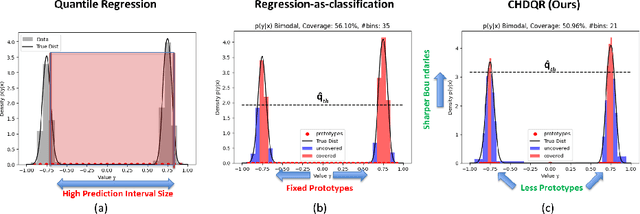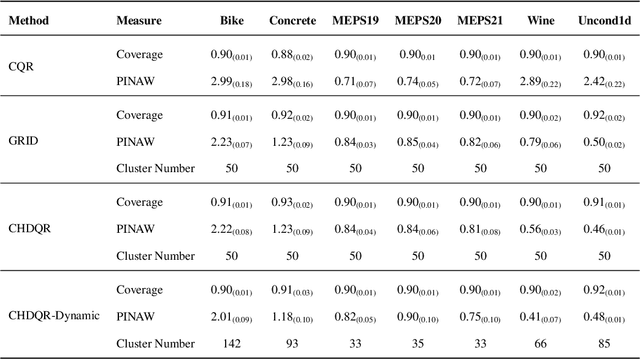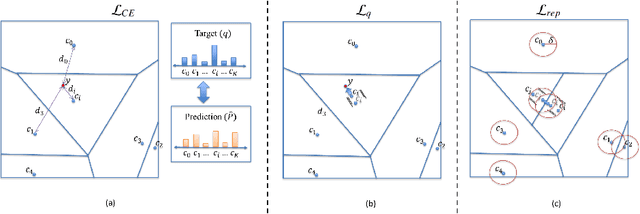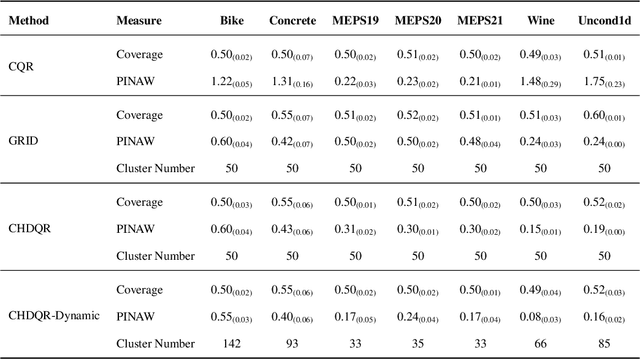Batuhan Cengiz
Conformalized High-Density Quantile Regression via Dynamic Prototypes-based Probability Density Estimation
Nov 02, 2024



Abstract:Recent methods in quantile regression have adopted a classification perspective to handle challenges posed by heteroscedastic, multimodal, or skewed data by quantizing outputs into fixed bins. Although these regression-as-classification frameworks can capture high-density prediction regions and bypass convex quantile constraints, they are restricted by quantization errors and the curse of dimensionality due to a constant number of bins per dimension. To address these limitations, we introduce a conformalized high-density quantile regression approach with a dynamically adaptive set of prototypes. Our method optimizes the set of prototypes by adaptively adding, deleting, and relocating quantization bins throughout the training process. Moreover, our conformal scheme provides valid coverage guarantees, focusing on regions with the highest probability density. Experiments across diverse datasets and dimensionalities confirm that our method consistently achieves high-quality prediction regions with enhanced coverage and robustness, all while utilizing fewer prototypes and memory, ensuring scalability to higher dimensions. The code is available at https://github.com/batuceng/max_quantile .
PCLD: Point Cloud Layerwise Diffusion for Adversarial Purification
Mar 11, 2024Abstract:Point clouds are extensively employed in a variety of real-world applications such as robotics, autonomous driving and augmented reality. Despite the recent success of point cloud neural networks, especially for safety-critical tasks, it is essential to also ensure the robustness of the model. A typical way to assess a model's robustness is through adversarial attacks, where test-time examples are generated based on gradients to deceive the model. While many different defense mechanisms are studied in 2D, studies on 3D point clouds have been relatively limited in the academic field. Inspired from PointDP, which denoises the network inputs by diffusion, we propose Point Cloud Layerwise Diffusion (PCLD), a layerwise diffusion based 3D point cloud defense strategy. Unlike PointDP, we propagated the diffusion denoising after each layer to incrementally enhance the results. We apply our defense method to different types of commonly used point cloud models and adversarial attacks to evaluate its robustness. Our experiments demonstrate that the proposed defense method achieved results that are comparable to or surpass those of existing methodologies, establishing robustness through a novel technique. Code is available at https://github.com/batuceng/diffusion-layer-robustness-pc.
epsilon-Mesh Attack: A Surface-based Adversarial Point Cloud Attack for Facial Expression Recognition
Mar 11, 2024Abstract:Point clouds and meshes are widely used 3D data structures for many computer vision applications. While the meshes represent the surfaces of an object, point cloud represents sampled points from the surface which is also the output of modern sensors such as LiDAR and RGB-D cameras. Due to the wide application area of point clouds and the recent advancements in deep neural networks, studies focusing on robust classification of the 3D point cloud data emerged. To evaluate the robustness of deep classifier networks, a common method is to use adversarial attacks where the gradient direction is followed to change the input slightly. The previous studies on adversarial attacks are generally evaluated on point clouds of daily objects. However, considering 3D faces, these adversarial attacks tend to affect the person's facial structure more than the desired amount and cause malformation. Specifically for facial expressions, even a small adversarial attack can have a significant effect on the face structure. In this paper, we suggest an adversarial attack called $\epsilon$-Mesh Attack, which operates on point cloud data via limiting perturbations to be on the mesh surface. We also parameterize our attack by $\epsilon$ to scale the perturbation mesh. Our surface-based attack has tighter perturbation bounds compared to $L_2$ and $L_\infty$ norm bounded attacks that operate on unit-ball. Even though our method has additional constraints, our experiments on CoMA, Bosphorus and FaceWarehouse datasets show that $\epsilon$-Mesh Attack (Perpendicular) successfully confuses trained DGCNN and PointNet models $99.72\%$ and $97.06\%$ of the time, with indistinguishable facial deformations. The code is available at https://github.com/batuceng/e-mesh-attack.
3D U-NetR: Low Dose Computed Tomography Reconstruction via Deep Learning and 3 Dimensional Convolutions
May 28, 2021



Abstract:In this paper, we introduced a novel deep learning based reconstruction technique using the correlations of all 3 dimensions with each other by taking into account the correlation between 2-dimensional low-dose CT images. Sparse or noisy sinograms are back projected to the image domain with FBP operation, then denoising process is applied with a U-Net like 3 dimensional network called 3D U-NetR. Proposed network is trained with synthetic and real chest CT images, and 2D U-Net is also trained with the same dataset to prove the importance of the 3rd dimension. Proposed network shows better quantitative performance on SSIM and PSNR. More importantly, 3D U-NetR captures medically critical visual details that cannot be visualized by 2D network.
 Add to Chrome
Add to Chrome Add to Firefox
Add to Firefox Add to Edge
Add to Edge